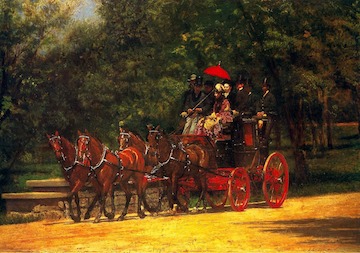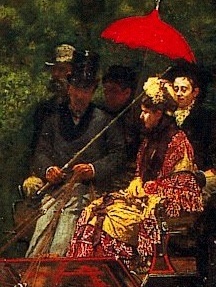By Andrew Huff
Acclaimed American realist Thomas Eakins’ A May Morning in the Park (1879) is a quiet wellspring of artistic innovation in the United States. The painting’s moniker—“The Fairman Rogers Four-in-Hand”—conceals the remarkable bond between painter and subject, Fairman Rogers (ΦBK, University of Pennsylvania, 1853) (Philadelphia Museum of Art: A May Morning in the Park).
Eakins gifted the work to Rogers, although art historian Elizabeth Milroy indicates in her PBS biography “Thomas Eakins: Scenes from Modern Life” that their collaboration extends deeper into the realm of art praxis.
Their own work can be seen as a personification of the interdisciplinary nature of Philadelphia at the time of the painting’s production.
According to the Philadelphia Museum of Art, nineteenth century Philadelphia captivated the nation’s attention for its interplay between the sciences, architecture, and artwork; it has described this piece in particular as a “visual anthem to the sciences” (Philadelphia Museum of Art: A May Morning in the Park).
The city functioned as a nexus of artistic and scientific instruction. The nation’s oldest museum and art institute, The Pennsylvania Academy of the Fine Arts (PAFA), was founded there in 1805, while the prestigious Thomas Jefferson Medical College opened in 1824.
In the 1860s, Eakins studied human anatomy at the college in addition to refining his craft at the PAFA; then, for two years he attended the L’École des Beaux Arts in Paris before returning to Philadelphia in 1870 (Pennsylvania Academy of the Fine Arts: Eakins the Artist).
According to the University of Pennsylvania Fairman Rogers Collection, in addition to quickly becoming a patron of the artist, Rogers recruited him in 1876 to teach life drawing classes at the PAFA and later named him director in 1882. At the time, Rogers served as the chairman of instruction at the PAFA, although like Eakins he embodied the liberal arts lifestyle.
The Fairman Rogers Collection notes that he held membership on the civil engineering faculty at the University of Pennsylvania, American Philosophical Society, and the Academy of Natural Sciences, in addition to founding the Philadelphia Coaching Club (“The Fairman Rogers Collection”).
Together at the Academy, the administrator and instructor collaborated personally on what would become A May Morning in the Park, and also devised a series of at-the-time radical scholastic reforms.
They formed a progressively hierarchical course structure moving students from beginner to advanced levels while charging tuition for the first time in the Academy’s history (Pennsylvania Academy of the Fine Arts, Research Archives). Rogers, according to the University of Pennsylvania archives, used his role as an administrator to lead revisions of the school’s internal policies to allow women to be admitted to the Academy and taught on the same basis as men (“The Fairman Rogers Collection”).
However, the most provocative change remained Eakins’ signature methodology: the emphasis on nude modeling and human anatomy in sketching (“The Pennsylvania Academy of the Fine Arts: Eakins the Teacher”). Eakins, to the chagrin of Victorian Philadelphia, lauded the virtues of embracing nudity as a muse rather than lifeless body casts (“1886: Eakins Resigns”).
Such brazen live modeling, though commonplace now, at the time only dismayed the PAFA administration. In 1886, Edward H. Coates (Rogers’ replacement as the Chairman of the Committee of Instruction at the PAFA), dismissed Eakins for removing a male model’s loincloth in front of female students (“1886: Eakins Resigns”).
Following the scandal, both men followed similar paths of withdrawal. The Fairman Rogers Collection notes that Rogers spent his retirement in Europe until his death in 1900 while Milroy details Eakins’ own relocation to North Dakota until the same year (Thomas Eakins: Scenes from Modern Life).
Nevertheless, the subtle, physical token of Eakins’ and Rogers’ perennial activity remains on permanent exhibition at the Philadelphia Museum of Art, a quiet testament to the powerful dynamism of collaboration between the arts and sciences.
Andrew Huff is a senior at Goucher College majoring in Political Science. Goucher College is home to the Beta of the Maryland Chapter of Phi Beta Kappa.

Thomas Eakins, A May Morning in the Park (1879)




